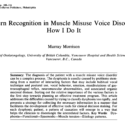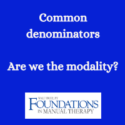Subscribe to the Newsletter To subscribe to the newsletter, sent 1-2 times a month, please send us an email. Continue Reading
Deeper Dives: Live Online Courses
Deeper Dives: Live Online Courses If you are looking for the Zoom link to your live class: To satisfy requests from clinicians who want to know more about the work I teach through the Foundations in Manual Therapy: Voice and Swallowing Disorders, I will begin offering live, Zoom-based 60-minute classes on specific topics or… Continue Reading
One-on-One Learning Options
In addition to traditional onsite group seminars at locations around the globe, I am now offering private, one-on-one offerings of the Foundations in Manual Therapy: Voice and Swallowing Disorders training. These private classes are available at my Upstate New York clinic, accessible from the Greater Rochester International Airport (ROC). This option may also be available… Continue Reading
Building self-determination in our patients
Building self-determination in our patients “What I find so hard to understand is how I continue to improve without seeing you regularly!”These words, paraphrased based on my memory, were recently said to me by a patient. I frustrate new patients when they ask me how frequently they should be seen, and I reply with a… Continue Reading
Shared Decision-Making
Shared Decision-Making in the Manual Therapy Setting Much of the past decade has been spent refining my approach to manual therapy. What began as a myofascial release (MFR) approach, one steeped in mysteries and presented from the position as clinician-as-expert, has evolved considerably. Based on my understandings of how manual therapy impacts the patient, I… Continue Reading
Why so aggressive?
Questions? Send an email or comment below. Walt Fritz, PT Foundations in Manual Therapy: Voice and Swallowing Disorders Continue Reading
Active cancer and manual therapy
Active cancer and manual therapy Walt Fritz, PT, Foundations in Manual Therapy: Voice and Swallowing Disorders Seminars May 23, 2022 Input encouraged on what I know to be a contentious topic. From a recent question about the safety of manual therapy used when a patient has active cancer, I endeavored to collect data on this… Continue Reading
Visual impacts of manual therapy
Internal views of externally applied interventions are a great way to see how touch may impact. Nothing guarantees change, but knowing what we know about patient perspectives and inclusion if we are able to reach and create awareness to centers responsible for voice and swallowing disorders, our chances of introducing change is quite good. Thanks… Continue Reading

Manual therapy to the retrolaryngeal “gutters”
Manual therapy to the retrolaryngeal “gutters” Accessing the area in front of the spinal transverse processes, for the past 28 years, I’ve used a manual therapy technique taught to me in 1994 as an anterior cervical technique for neck and arm pain. Though fraught with outdated concepts of cause and effect, the hands-on sequences proved… Continue Reading
Review of Inner Jaw Self-Treatment Tools
Review of Inner Jaw Self-Treatment Tools In the quest to offer more self-treatment options/solutions to patients with jaw-related issues (TMD, radiation-induced trismus), specifically for accessing the interior mandibular (aka pterygoid) region, I tested three products. From the perspective of treatment, placing a finger into the area between the ramus of the mandible and upper row… Continue Reading
Wedge Revival
Wedge Revival Recognize these? Various professions use pelvic wedges to “balance the pelvis” or other more nefarious (manipulative) usages. In my early training, I was presented with a decidedly biomechanical model of causation and intervention. If the body is misaligned, this was seen as the cause of problems, along with restricted fascia and emotional stuck-ness… Continue Reading
Arlington, TX: Hybrid Foundations in Manual Therapy: Voice and Swallowing Disorders
Arlington, TX: Hybrid Foundations in Manual Therapy: Voice and Swallowing Disorders Below is the payment link to register for this hybrid seminar. This is a closed class and available only to employees of Rehab Synergies. After registering please email from the “Contact” link in the menu bar at the top of this page to request… Continue Reading

Riffs and mods
Riffs and Mods Most of us learn manual therapy (MFR, massage, trigger point work, etc.) from a specific paradigm, one that defines a protocol or sequence. That sequence is based on the perception of tissue-based problems and tissue-based solutions. MFR was said to be non-protocol-based, but even they define their terms and rules: always wait… Continue Reading
Demonizing Manual Therapy
Demonizing Manual Therapy A new article came to my attention today, one written by Chad Cook, PT, Ph.D., titled, The Demonization of Manual Therapy. Chad has been a defender of manual therapy as a valuable adjunct to many interventions and has put up some great podcasts and interviews that I’ve enjoyed over the past two… Continue Reading

Are we the modality? A common denominator
Are we the modality? A common denominator The longer I exist in the world of manual therapy, the more I see little difference between styles of work or modalities. Despite claims of unique access to single tissues or pathologies, all manual therapy is performed in remarkably similar ways. What are the underlying qualities of each… Continue Reading

Putting patient preferences and values back in EBP
Putting patient preferences and values back in EBP Evidence-based practice (EBP) has been the accepted norm in medicine and rehabilitation for nearly 30 years, though exploration began of its concepts in the early 1970s (Zimerman, 2013). EBP consists of three elements: the best available evidence, the clinician’s knowledge, and skills, and the patient’s wants and… Continue Reading

